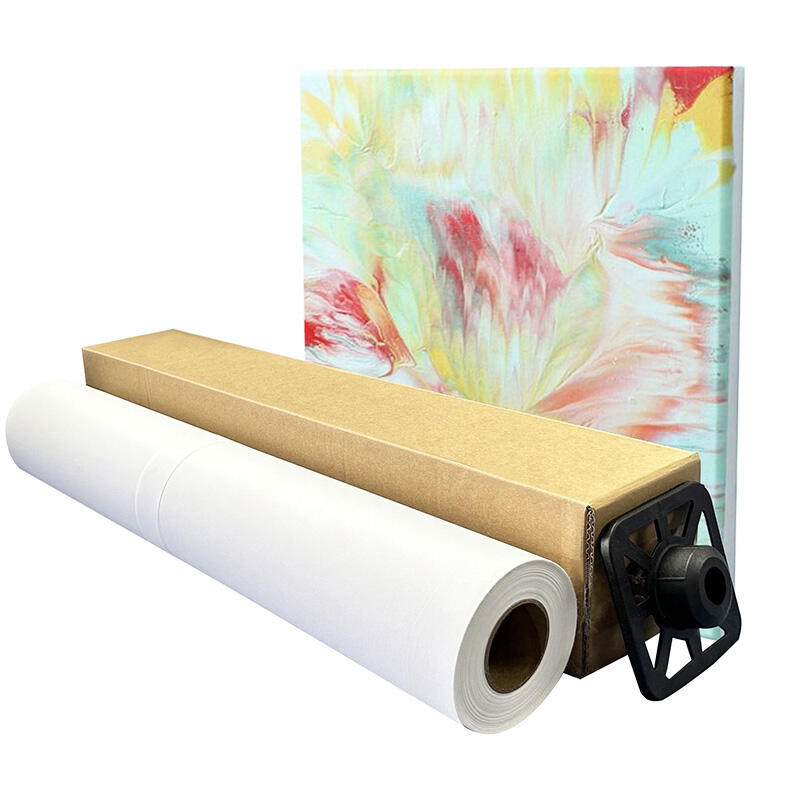The art world is experiencing a significant shift toward sustainable materials as creators become increasingly conscious of their environmental impact. While traditional decorative vinyl has long been a staple in various artistic applications, artists and manufacturers are now exploring eco-friendly alternatives that maintain quality while reducing ecological footprint. Cotton canvas emerges as a compelling sustainable option that bridges the gap between environmental responsibility and artistic excellence.

The transition from synthetic materials to natural fiber alternatives represents more than just an environmental choice—it reflects a fundamental shift in how we approach art creation and material selection. Cotton canvas offers unique properties that make it suitable for various applications traditionally dominated by plastic-based materials. Understanding these characteristics helps artists and businesses make informed decisions about their material choices while maintaining the aesthetic and functional qualities they require.
Understanding Cotton Canvas as a Sustainable Alternative
Natural Fiber Composition and Environmental Benefits
Cotton canvas consists of natural fibers woven into a durable, versatile fabric that offers remarkable strength and flexibility. Unlike synthetic alternatives such as decorative vinyl, cotton canvas biodegrades naturally at the end of its lifecycle, significantly reducing long-term environmental impact. The production process for cotton canvas typically requires less energy-intensive manufacturing compared to petroleum-based synthetic materials, making it an attractive option for environmentally conscious consumers.
The cultivation of organic cotton further enhances the environmental benefits of canvas materials. Organic cotton farming practices eliminate harmful pesticides and synthetic fertilizers, protecting soil health and reducing water contamination. This sustainable approach to raw material production creates a positive ripple effect throughout the entire supply chain, from fiber cultivation to final product manufacturing.
Durability and Performance Characteristics
High-quality cotton canvas demonstrates exceptional durability that rivals many synthetic alternatives. The natural fiber structure provides inherent flexibility while maintaining dimensional stability under various environmental conditions. This combination of properties makes cotton canvas suitable for both temporary and permanent artistic applications, offering versatility that matches the performance expectations traditionally associated with synthetic materials.
The breathable nature of cotton canvas provides advantages in applications where moisture management is important. Unlike some synthetic materials that can trap moisture and lead to adhesion problems, cotton canvas allows for natural air circulation, reducing the risk of mold, mildew, and other moisture-related issues that can compromise artistic projects.
Applications in Art and Design Projects
Fine Art and Canvas Painting
Traditional canvas painting represents the most established application for cotton canvas in artistic endeavors. The natural texture and absorbency of cotton fibers create an ideal surface for various painting mediums, from oil and acrylic paints to watercolors and mixed media applications. Artists appreciate the way cotton canvas interacts with paint, providing excellent adhesion while allowing for easy blending and layering techniques.
The archival quality of properly prepared cotton canvas ensures that artwork created on this substrate will maintain its integrity over time. Unlike some synthetic surfaces that may yellow or degrade with age, high-quality cotton canvas provides a stable foundation that preserves the artist's original vision for generations. This longevity factor makes cotton canvas particularly valuable for professional artists and collectors who prioritize the long-term preservation of artistic works.
Decorative and Commercial Applications
Beyond traditional fine art applications, cotton canvas serves various decorative and commercial purposes that previously relied heavily on synthetic materials. Interior designers increasingly specify cotton canvas for wall coverings, room dividers, and decorative panels that require both aesthetic appeal and environmental responsibility. The natural texture of cotton canvas adds visual interest and tactile quality that enhances interior spaces while supporting sustainable design principles.
Commercial printing applications have also embraced cotton canvas as an alternative to synthetic substrates. Digital printing technologies work exceptionally well with properly treated cotton canvas, producing vibrant colors and sharp detail that meet professional standards. This compatibility allows businesses to maintain high-quality output while reducing their environmental footprint through material selection.
Manufacturing and Processing Considerations
Sustainable Production Methods
Modern cotton canvas manufacturing employs increasingly sustainable production methods that minimize environmental impact throughout the process. Water-based treatments and eco-friendly sizing compounds replace traditional chemical treatments, reducing toxic waste and improving worker safety. These advances in manufacturing technology enable producers to create high-performance cotton canvas while maintaining strict environmental standards.
Energy-efficient weaving processes and renewable energy sources further reduce the carbon footprint associated with cotton canvas production. Many manufacturers now implement closed-loop water systems that recycle and purify process water, dramatically reducing water consumption and eliminating contaminated discharge. These technological improvements demonstrate that sustainable manufacturing practices can coexist with high-quality product output.
Quality Control and Standards
Establishing consistent quality standards for cotton canvas requires careful attention to fiber selection, weaving density, and finishing processes. Premium cotton canvas manufacturers implement rigorous testing protocols that evaluate tensile strength, dimensional stability, and surface characteristics to ensure consistent performance across product batches. These quality control measures help build confidence among artists and businesses transitioning from synthetic alternatives to natural fiber options.
Certification programs and industry standards play a crucial role in validating the quality and sustainability claims associated with cotton canvas products. Third-party testing and certification provide independent verification of performance characteristics and environmental compliance, helping consumers make informed purchasing decisions based on reliable information rather than marketing claims alone.
Economic and Market Considerations
Cost Analysis and Value Proposition
The economic considerations surrounding cotton canvas adoption involve both initial cost comparisons and long-term value assessments. While premium cotton canvas may carry a higher upfront cost compared to some synthetic alternatives like decorative vinyl, the durability and longevity of natural fiber materials often provide superior value over the product lifecycle. This economic advantage becomes particularly apparent in applications where material replacement costs and environmental disposal fees factor into total cost calculations.
Market demand for sustainable materials continues to drive competitive pricing in the cotton canvas sector. Increased production volumes and improved manufacturing efficiency help reduce per-unit costs while maintaining quality standards. This trend makes cotton canvas increasingly accessible to price-sensitive markets that previously relied exclusively on synthetic alternatives.
Supply Chain and Availability
The global supply chain for cotton canvas benefits from well-established agricultural and textile manufacturing networks that ensure consistent availability and competitive pricing. Unlike some specialty sustainable materials that suffer from limited production capacity, cotton canvas leverages existing infrastructure and expertise developed over centuries of textile production. This mature supply chain provides stability and reliability that businesses require for long-term planning and inventory management.
Regional sourcing opportunities for cotton canvas allow businesses to reduce transportation costs and carbon emissions while supporting local economies. Many textile regions offer complete vertical integration from cotton cultivation through finished canvas production, enabling shorter supply chains and greater quality control throughout the manufacturing process.
Future Trends and Innovations
Technological Advancements
Emerging technologies continue to enhance the performance characteristics and application possibilities for cotton canvas materials. Advanced fiber treatments improve water resistance, UV stability, and flame retardancy without compromising the natural, biodegradable properties that make cotton canvas environmentally attractive. These technological innovations expand the range of applications where cotton canvas can effectively replace synthetic alternatives.
Digital printing technology specifically optimized for natural fiber substrates represents another significant advancement in cotton canvas applications. Improved ink formulations and printing processes deliver enhanced color reproduction and durability while maintaining compatibility with sustainable material principles. These technological developments support the growing demand for high-quality, environmentally responsible printing solutions.
Market Evolution and Consumer Preferences
Consumer preferences increasingly favor products that demonstrate clear environmental benefits without sacrificing performance or aesthetic quality. This market evolution drives continued investment in cotton canvas research and development, leading to improved products that meet or exceed the performance characteristics of synthetic alternatives. Understanding these consumer trends helps businesses position cotton canvas effectively in competitive markets.
The integration of cotton canvas into mainstream commercial applications continues to expand as awareness of environmental issues grows and sustainable alternatives become more accessible. This trend creates opportunities for innovative applications and market expansion that benefit both environmental goals and business objectives.
FAQ
How does cotton canvas compare to synthetic alternatives in terms of durability?
Cotton canvas offers excellent durability characteristics that often match or exceed synthetic alternatives when properly manufactured and treated. The natural fiber structure provides inherent flexibility and strength that resists tearing and maintains dimensional stability over time. While specific performance varies based on application and environmental conditions, high-quality cotton canvas typically provides service life comparable to synthetic materials while offering superior end-of-life disposal options.
What are the main environmental advantages of choosing cotton canvas over synthetic materials?
The primary environmental advantages include biodegradability, renewable resource utilization, and reduced petroleum dependency. Cotton canvas naturally decomposes at the end of its useful life, eliminating long-term waste accumulation problems associated with synthetic materials. The production process typically generates lower carbon emissions and uses less energy compared to petroleum-based alternatives, while organic cotton cultivation further reduces environmental impact through eliminated pesticide and synthetic fertilizer use.
Can cotton canvas achieve the same print quality as synthetic substrates?
Modern cotton canvas formulated for digital printing applications can achieve print quality that meets or exceeds professional standards. Proper surface preparation and ink compatibility ensure excellent color reproduction, sharp detail resolution, and adequate ink adhesion. While the natural texture of cotton canvas creates a different aesthetic compared to smooth synthetic surfaces, many applications benefit from this organic texture that adds visual interest and tactile appeal to printed graphics.
What factors should be considered when transitioning from synthetic to cotton canvas materials?
Key transition factors include application requirements, performance specifications, cost considerations, and supply chain compatibility. Evaluate the specific performance needs of your application, including durability requirements, environmental exposure, and aesthetic preferences. Consider the total cost of ownership including initial purchase price, installation costs, maintenance requirements, and disposal fees. Assess supply chain factors such as availability, lead times, and quality consistency to ensure smooth transition and ongoing operations.
Table of Contents
- Understanding Cotton Canvas as a Sustainable Alternative
- Applications in Art and Design Projects
- Manufacturing and Processing Considerations
- Economic and Market Considerations
- Future Trends and Innovations
-
FAQ
- How does cotton canvas compare to synthetic alternatives in terms of durability?
- What are the main environmental advantages of choosing cotton canvas over synthetic materials?
- Can cotton canvas achieve the same print quality as synthetic substrates?
- What factors should be considered when transitioning from synthetic to cotton canvas materials?

